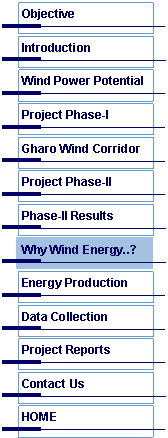



|
Pakistan Meteorological Department has conducted a detailed Wind Power Potential Survey of Coastal Areas of Pakistan and Ministry of Science and Technology has provided the required funding for this purpose. This study has enabled us to identify the potential areas where economically feasible wind farm can be established. One interesting aspect of this study is that contrary to the general impression, Sindh coastal areas have greater wind power potential than Balochistan coastal areas. Potential areas cover 9700 sq.km in Sindh. The gross wind power potential of this area is 43000 MW and keeping in view the area utilization constrains etc. the exploitable electric power generation potential of this area is estimated to be about 11000MW.
Feasibility study for the installation of 18 MW Model wind power project is prepared. Total cost of the project is estimated to be about Rs. 850 million and the pay back period would be 7-8 years. The levelised cost of power generation is estimated as Rs. 2.9/kwh.
Introduction:
The demand for energy has increased in tremendous proportions in the last few decades in Pakistan; the same is expected to increase further in the coming years. The primary sources of energy available in Pakistan are oil, natural gas, hydro and nuclear Power. At present oil accounts for approximately 45% of total commercial energy supply. The share of natural gas is 34% while that of hydel power remains roughly at 15%. The increase in cost of fossil fuel and the various environmental problems of large scale power generation have lead to increased appreciation of the potential of electricity generation from non-conventional sources. This has provided the planners and economists to find out other low cost energy resources. Wind and Solar energies are the possible clean and low cost renewable resources available in the country. The potential, for the use of alternative technologies, has never been fully explored in Pakistan. Wind power provides opportunity to reduce dependence on imported fossil fuel and at the same time expands the power supply capacity to remote locations where grid expansion is not practical. Recently conducted survey of Wind Power Potential along coastal areas of the country by Pakistan Meteorological Department (PMD), indicates that a potential exists for harvesting wind energy using currently available technologies, especially along Sindh coast.
Gharo, one of the sites in Sindh where the wind data have been recorded and studied by PMD, has been selected for this feasibility study. The wind measurements at Gharo have been carried out during 24 months period. The annual mean wind speed is estimated to be 6.86m/s at 50 meter above ground level. The annual power density of area is 408.6 W/m2, which bring the site into good category of power potential, which means this area is suitable for large economically viable wind farm.
Using the measured wind data the annual gross energy production by an 18 MW wind farm consisting of thirty – 600 kW turbines will be 45 million kWh. Taking into account the wind turbine availability, net losses and wake effects in the wind farm the net annual energy production is estimated to 31 million kWh per year corresponding to a capacity factor of 28%.
The total investment will be Rs: 850 million and pay back period will be 7-8 years. The capital cost of wind power projects ranges Rs 4 to 5 crore per MW. This gives a levelised cost of wind energy generation in the range of Rs: 2.50 to 3.00 per kWh, taking into consideration the fiscal benefits extended by the government. Performance Generally wind farm located in area with good winds and having a typical value of capacity factor i.e. 25% at least are economically viable. A typical life of wind turbine is 20 to 25 years. Maintenance is required at 6 months interval.
The total investment for the proposed project is Rs: 850 million and pay back period 7-8 years. The capital cost of a typical wind power project ranges Rs 4 to5 crore per MW. This gives a levelised cost of wind energy generation in the range of Rs: 2.5 to 3.00 per kWh, taking into consideration the fiscal benefits extended by the government. Different economic aspects of the project are shown in table 4, 5 & 6.
Risks Associated with Investments in Wind Power
i. The returns from investments in this sector are very dependent on government policies, both in terms of the incentives given and the taxation structure imposed on businesses. Hence changes in either are a source of concern to the investors. For example, changes in the tax laws that make all companies liable to pay a minimum tax on their profits, may negatively affect the wind program because it reduces the benefit from the tax shelter that investments here could provide. ii. The main “fuel” controlling generation in any year is the wind speed. This is beyond the investor’s control: there is always the risk that actual generation in any year could be below the expected level. iii. Grid availability to evacuate the generated power is an essential requirement. Poor grid availability and reliability are again risks that have to be borne by the investors under the current situation.
Wind Potential Area of Sindh
Total Area of Sindh suitable for wind farms = 9749 km2 Average Capacity Factor of this area in Sindh = 25% Wind power potential of 18MW Wind Farm on 1 km2 area when Capacity Factor is 25% =18x0.25=4.5 MW
Gross Potential of the area corresponding to 25%Capacity Factor=9749x 4.5=43871 MW Exploitable Potential ( 25% of the area) ≈ 11000 MW
The Benefits of Wind Energy Wind energy is an ideal renewable energy because: 1. it is a pollution-free, infinitely sustainable form of energy 2. it doesn’t require fuel 3. it doesn’t create greenhouse gasses it doesn’t produce toxic or radioactive waste.
Wind energy is quiet and does not present any significant hazard to birds or other wildlife. When large arrays of wind turbines are installed on farmland, only about 2% of the land area is required for the wind turbines. The rest is available for farming, livestock, and other uses. Landowners often receive payment for the use of their land, which enhances their income and increases the value of the land. Ownership of wind turbine generators by individuals and the community allows people to participate directly in the preservation of our environment. Each megawatt-hour of electricity that is generated by wind energy helps to reduce 0.8 to 0.9 tones of greenhouse gas emissions that are produced by coal or diesel fuel generation each year. |

|
Copyright © 2008 Pakistan Meteorological Department. All Rights Reserved. |

|
Pakistan Meteorological Department WIND ENERGY PROJECT A Project funded by Ministry of Science & Technology |
|
Why Wind energy...? |